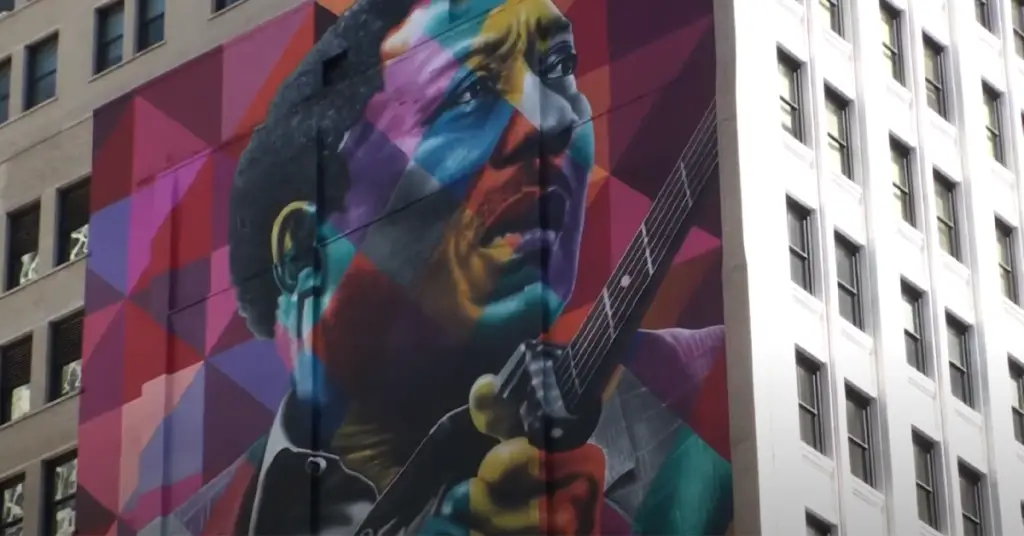Where Blues History Towers Over the Loop
Why a Blues Legend Belongs on a Skyscraper
Chicago is a city that wears its music on its sleeve. From South Side clubs to downtown festivals, the sound of the city is the blues—and few artists embody that spirit like Muddy Waters. The 10-story mural of Muddy towering over Chicago’s Loop isn’t just an eye-catching piece of street art; it’s a sky-high acknowledgement that the city’s modern identity was electrified by the Mississippi Delta’s most influential son.
The mural’s scale mirrors his impact. Muddy helped plug the Delta into an amplifier, turning acoustic laments into urban electricity. Rock, soul, and R&B owe him a debt. This mural turns that cultural ledger into a public monument.
The Vision: Street Art Meets the Blues
Painted in a bold mosaic style with prismatic facets and crisp contours, the mural transforms a flat façade into a living album cover. The color palette—vivid yet balanced—feels like a visual version of a sustained guitar bend: alive, expressive, and unmistakably bluesy. From street level, you see Muddy’s intense focus; from a block away, his silhouette becomes an icon, instantly recognizable even to casual passersby.
Beyond aesthetics, the mural serves a civic purpose. It links downtown foot traffic to the city’s South Side blues heritage, nudging visitors from the Loop toward record shops, venues, and museums that preserve the real story.
Why Muddy Waters, Why Chicago
- Cultural Anchor: Muddy Waters migrated from Mississippi to Chicago, amplifying country blues into the electric Chicago blues that would inspire the Rolling Stones, Led Zeppelin, and countless guitar heroes.
- Local Legacy: His classic recordings for Chess Records reshaped pop music. Standing under the mural, you’re a short journey from the neighborhoods and studios where those sides were cut.
- Public History: Instead of commemorating music history inside a museum alone, the city makes the story unavoidable—part of the daily commute, lunch breaks, and tourist selfies.
Where to Find It & How to See It Best
You’ll spot the mural in Chicago’s Loop, rising along the canyon of high-rises. Because it’s 10 stories tall, you don’t need to be right beneath it to appreciate the full composition—sometimes the best vantage is across the street on the opposite sidewalk, where the perspective lets the geometry breathe.
Photography tips:
- Wide first, details second: Capture the full height from a corner across the intersection; then walk closer for the expressive facial planes and guitar details.
- Golden hour glow: Early morning or late afternoon light softens contrast on the building’s surface and enriches color.
- Street context: Include pedestrians, bus lines, and storefronts to show scale—Muddy looks even more monumental when framed by city life.
From Wall to Wayfinding: Building a Blues Trail
Public art like the Muddy Waters mural naturally becomes a wayfinding beacon. Use it as a starting point for an afternoon blues walk:
- Start at the mural in the Loop: take photos and read any nearby plaques or project notes if posted.
- Head toward the Chicago Cultural Center for rotating exhibits and architecture eye candy.
- Explore blues record shops (vinyl bins often have Chess, Checker, and Argo treasures).
- Finish at a blues club for a night set—because the mural is the overture, not the finale.
What the Mural Says About Chicago Today
Chicago is historically a city of makers—steel, stockyards, skyscrapers. The mural adds a modern chapter: a city that makes culture in public, not just behind velvet ropes. It celebrates a Black American art form as essential urban heritage, not nostalgia. And it challenges passersby to reconsider how we honor artists: not merely with plaques, but with architecture-scale tributes as bold as the music itself.

Classroom & Family Guide: Learn the Blues on the Block
Bringing students or young music fans? Use the mural as a participatory lesson:
- Sound vs. Color: Ask how the mural’s color blocks might translate to musical elements—bends, shout-choruses, walking bass lines.
- Migration Map: Trace the Great Migration: How did movement from Mississippi to Chicago change the sound and the business of music?
- Influence Tree: Start with Muddy, branch to Howlin’ Wolf and Willie Dixon, then to the British blues boom and the modern guitar scene.
Practical Visiting Tips
- Footwear & time: The Loop is walkable—pair the mural with a coffee run or a midday stroll between attractions.
- Weather backup: Chicago’s weather can flip fast. If it rains, the mural still photographs beautifully—reflections in puddles add drama.
- Respect the space: It’s a working city street. Be mindful of traffic, loading zones, and building entrances when lining up shots.
Why It Matters (Still)
Monuments don’t only commemorate the past; they shape the present. This 10-story Muddy Waters mural frames Chicago as a city that recognizes its cultural roots while inviting new audiences to listen closer. For lifelong fans, it’s a moment of recognition. For newcomers, it’s an irresistible question mark: Who is that? Why is he up there? Follow the curiosity, and you’ll find the soundtrack of the city.
Thank You
We appreciate your time and dedication to reading our article. For more of the finest blues guitar music, make sure to follow our Facebook page, “I Love Blues Guitar”. We share exceptional selections every day. Thank you once again for your continued support and readership.


Facebook Comments